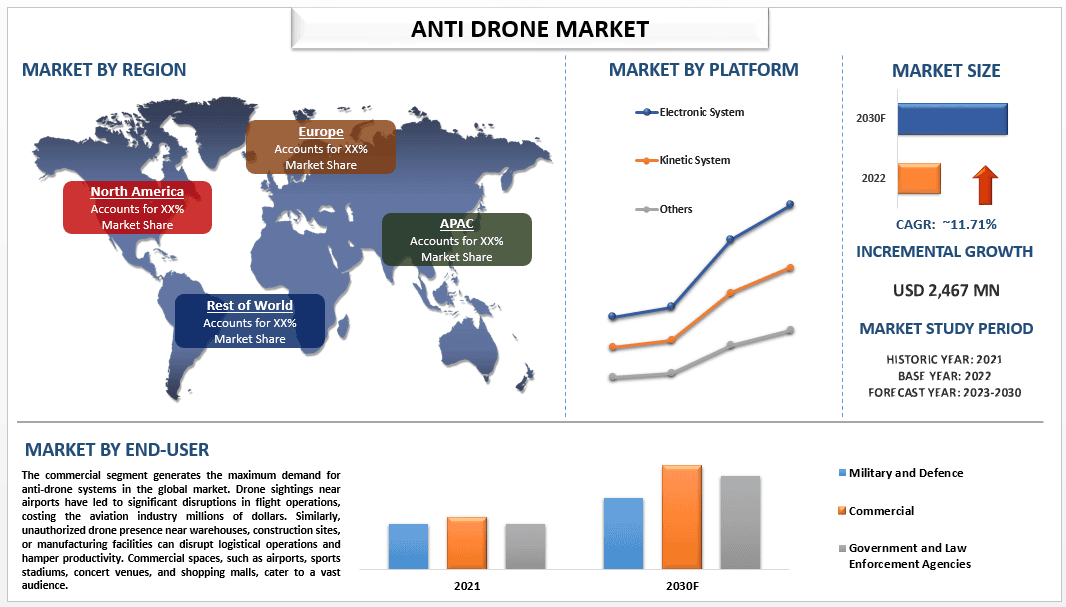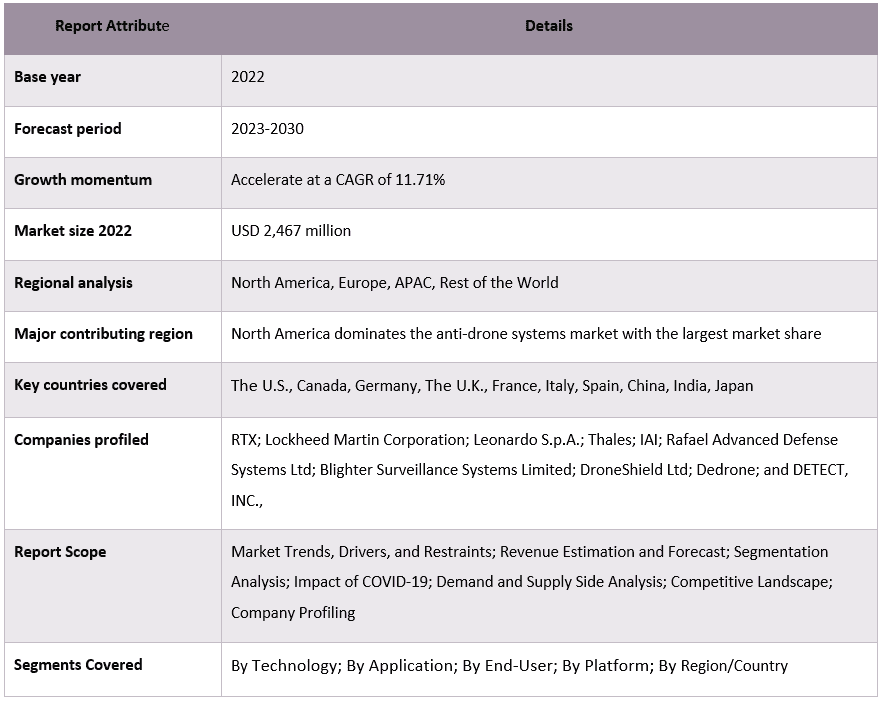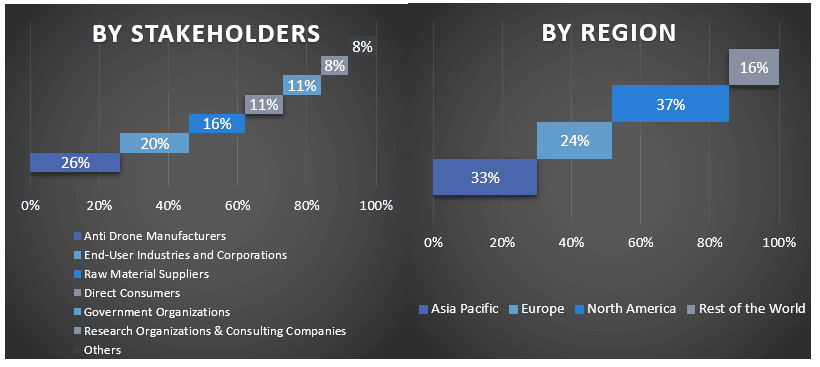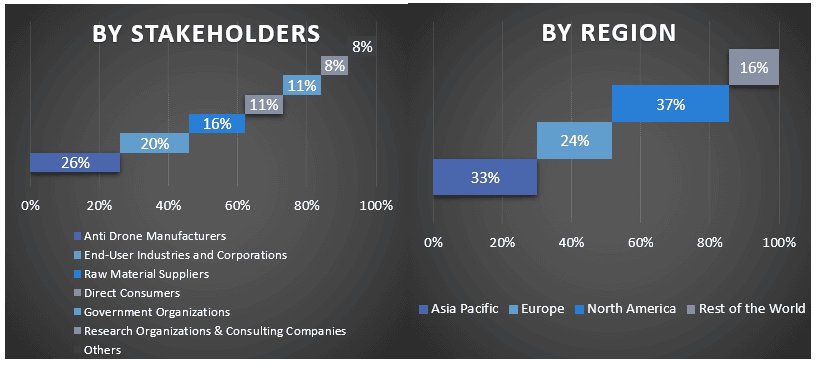Emphasis on Technology (Electronic Systems, Kinetic Systems, and Others); Application (Detection, and Detection and Disruption); End-User (Military and Defense, Commercial, and Government and Law Enforcement Agencies); Platform (Ground, Handheld, and UAV Based); and Region/Country

The Anti-Drone Market was valued at 2,467 million in the year 2022 and is expected to grow at a strong rate of around 11.71% during the forecast period (2023-2030), owing to the rising use of consumer drones globally. Furthermore, consumer drones have gained immense popularity, revolutionized various industries, and captured imaginations worldwide. However, with the proliferation of these unmanned aerial vehicles (UAVs) comes the pressing need for countermeasures to mitigate potential threats. As a result, the market for anti-drone systems is experiencing tremendous growth globally. While most drone enthusiasts operate responsibly, the unauthorized use of consumer drones has led to concerns over privacy, security breaches, and disruption of critical operations. Incidents of drone sightings near airports, unauthorized photography, and smuggling attempts highlight the vulnerabilities that need to be addressed urgently. Protecting critical infrastructure, public events, and sensitive areas from such threats necessitates the deployment of robust anti-drone systems. For instance, a notable event occurred in 2018 when London Gatwick Airport experienced the disruption of approximately 1,000 flights due to drone activity, impacting over 140,000 passengers. The resulting economic loss from the 33-hour disruption was estimated at around EUR 55.8 million.
Some of the major players operating in the market include RTX; Lockheed Martin Corporation; Leonardo S.p.A.; Thales; IAI; Rafael Advanced Defense Systems Ltd; Blighter Surveillance Systems Limited; DroneShield Ltd; Dedrone; and DETECT, INC., Several M&As along with partnerships have been undertaken by these players to facilitate customers with hi-tech and innovative products/technologies.
Insights Presented in the Report
“Amongst technology, the electronic system segment held the significant market share in 2022.”
Based on technology, the market is segmented into electronic systems, kinetic systems, and others. Among these categories, the electronic system dominates the market with the largest share. The electronic system utilizes various technologies such as radar, radio frequency, and infrared to detect drones based on their radar signature. Additionally, these system employs technologies like RF and GNSS jamming to disrupt the radio frequency connection between the drone and its operator, or to interfere with the drone’s satellite link, thereby prohibiting unidentified aircraft from operating in the area. The electronic systems’ popularity stems from their ease of installation and use, greatly contributing to their widespread growth.
“Amongst applications, the detection and disruption held a significant market share in 2022.”
Based on application, the anti-drone market is bifurcated into detection and detection and disruption. The detection and disruption anti-drone system dominated the market in terms of market share. The primary reason behind the domination is their comprehensive approach to countering drone threats. Unlike detection-only systems, which solely identify the presence of drones, detection, and disruption systems are equipped with the ability to actively mitigate the threat. These systems offer a multi-layered defense mechanism that ensures the effective neutralization of unauthorized drones, and factors like these have played a pivotal role in the ever-increasing popularity of detection and disruption of anti-drone systems.
Anti-Drone Market Report Coverage

“North America held the majority of the market share globally in 2022.”
North America holds a significant portion of the anti-drone market and is projected to experience substantial growth in the predicted timeframe. Security is given great importance in various sectors within North America, including infrastructure, defense, public safety, and large-scale events. This heightened focus on security is a direct response to the changing threat landscape, where drones can be exploited for illegal activities, such as smuggling, terrorism, and invasion of privacy. The increasing recognition of these risks has driven the demand for anti-drone systems that can safeguard critical infrastructure and mitigate potential threats. Moreover, the defense and military sectors in North America have acknowledged the significance of countering drone threats. The utilization of drones in unconventional warfare tactics during conflicts has necessitated the development of robust anti-drone technologies. Defense agencies are actively searching for solutions that can detect, track, and neutralize hostile unmanned aerial vehicles (UAVs) to safeguard their assets, troops, and borders. For instance, In April 2022, American company Amentum was awarded a USD 260 million contract to demonstrate and evaluate C-UAS technologies and systems, for the Department of Homeland Security (DHS). This includes R&D and testing capabilities in the areas of C-UAS-related cyber vulnerabilities, radio frequency spectrum measurements, and integration and deployment of prototype C-UAS systems across various mission areas. Around USD 240 million is expected to be spent on this program over the period 2023-2028.
Reasons to buy this report:
Customization Options:
The global anti-drone market can further be customized as per the requirement or any other market segment. Besides this, UMI understands that you may have your own business needs, hence feel free to contact us to get a report that completely suits your requirements.
1. Market Introduction
2. Research Methodology Or Assumption
3. Market Synopsis
4. Executive Summary
5. Impact Of Covid-19 On The Anti-drone Market
6. Anti Drone Market Revenue (usd Bn), 2020-2030f.
7. Market Insights By Technology
8. Market Insights By Application
9. Market Insights By End-user
10. Market Insights By Platform
11. Market Insights By Region
12. Anti-drone Market Dynamics
13. Anti-drone Market Opportunities
14. Anti-drone Market Trends
15. Demand And Supply-side Analysis
16. Value Chain Analysis
17. Competitive Scenario
18. Company Profiled
19. Disclaimer
Research Methodology for the Anti-Drone Market Analysis (2023-2030)
Analyzing the historical market, estimating the current market, and forecasting the future market of the global anti-drone market were the three major steps undertaken to create and analyze the adoption of anti-drones in major regions globally. Exhaustive secondary research was conducted to collect the historical market numbers and estimate the current market size. Secondly, to validate these insights, numerous findings and assumptions were taken into consideration. Moreover, exhaustive primary interviews were also conducted, with industry experts across the value chain of the global anti-drone market. Post assumption and validation of market numbers through primary interviews, we employed a top-down/bottom-up approach to forecasting the complete market size. Thereafter, market breakdown and data triangulation methods were adopted to estimate and analyze the market size of segments and sub-segments of the industry pertains to. Detailed methodology is explained below:
Analysis of Historical Market Size
Step 1: In-Depth Study of Secondary Sources:
A detailed secondary study was conducted to obtain the historical market size of the anti-drone market through company internal sources such as annual reports & financial statements, performance presentations, press releases, etc., and external sources including journals, news & articles, government publications, competitor publications, sector reports, third-party database, and other credible publications.
Step 2: Market Segmentation:
After obtaining the historical market size of the anti-drone market, we conducted a detailed secondary analysis to gather historical market insights and share for different segments & sub-segments for major regions. Major segments are included in the report as technology, application, end-user, and platform. Further country-level analyses were conducted to evaluate the overall adoption of testing models in that region.
Step 3: Factor Analysis:
After acquiring the historical market size of different segments and sub-segments, we conducted a detailed factor analysis to estimate the current market size of the Anti-Drone market. Further, we conducted factor analysis using dependent and independent variables such as purity and application of the anti-drone market. A thorough analysis was conducted of demand and supply-side scenarios considering top partnerships, mergers and acquisitions, business expansion, and product launches in the anti-drone market sector across the globe.
Current Market Size Estimate & Forecast
Current Market Sizing: Based on actionable insights from the above 3 steps, we arrived at the current market size, key players in the global Anti-Drone market, and market shares of the segments. All the required percentage shares split and market breakdowns were determined using the above-mentioned secondary approach and were verified through primary interviews.
Estimation & Forecasting: For market estimation and forecast, weights were assigned to different factors including drivers & trends, restraints, and opportunities available for the stakeholders. After analyzing these factors, relevant forecasting techniques i.e., the top-down/bottom-up approach were applied to arrive at the market forecast for 2030 for different segments and sub-segments across the major markets globally. The research methodology adopted to estimate the market size encompasses:
Market Size and Share Validation
Primary Research: In-depth interviews were conducted with the Key Opinion Leaders (KOLs) including Top Level Executives (CXO/VPs, Sales Head, Marketing Head, Operational Head, Regional Head, Country Head, etc.) across major regions. Primary research findings were then summarized, and statistical analysis was performed to prove the stated hypothesis. Inputs from primary research were consolidated with secondary findings, hence turning information into actionable insights.
Split of Primary Participants in Different Regions

Market Engineering
The data triangulation technique was employed to complete the overall market estimation and to arrive at precise statistical numbers for each segment and sub-segment of the global anti-drone market. data was split into several segments & sub-segments post studying various parameters and trends in the areas of purity and application in the global anti-drone market.
The main objective of the Global Anti-Drone Market Study
The current & future market trends of the global anti-drone market were pinpointed in the study. Investors can gain strategic insights to base their discretion for investments on the qualitative and quantitative analysis performed in the study. Current and future market trends determined the overall attractiveness of the market at a regional level, providing a platform for the industrial participant to exploit the untapped market to benefit from a first-mover advantage. Other quantitative goals of the studies include:

Q1: What is the current market size and growth potential of the global Anti-Drone market?
Q2: What are the driving factors for the growth of the global Anti-Drone Market?
Q3: Which segment has the largest share of the global anti-drone market by Technology?
Q4: What are the emerging technologies and trends in the global anti-drone market?
Q5: Which region will dominate the global anti-drone market?
Q6: Who are the key players in the global Anti-Drone market?
Customers who bought this item also bought